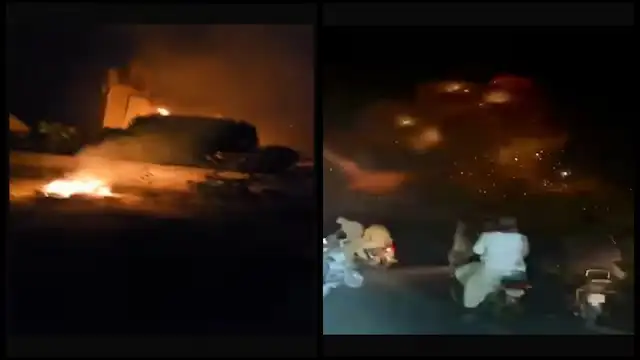Operation Sindoor: Satellite Imagery Reveals the Aftermath of Indian Strikes in Pakistan
Pakistan, May 7, 2025 – In a significant military operation, the Indian armed forces launched precise missile strikes targeting terrorist hideouts within Pakistan and Pakistan-occupied Kashmir (PoK) on Wednesday. This operation, dubbed Operation Sindoor, has garnered attention not only for its strategic aim but also for the visual evidence provided by satellite imagery, which clearly shows the damage caused by these targeted attacks.

The strikes, which took place at dawn, formed part of India’s ongoing efforts to counteract terrorism and disrupt terror cells operating along its borders. While the military usually carries out such operations in secrecy, the recent release of satellite images gives the public and analysts the opportunity to assess the aftermath and understand the scope of the military action.
Satellite Footage Highlights the Scale of the Strikes
In the aftermath of the operation, multiple satellite images have emerged, showing the extent of the damage inflicted on various locations across PoK and northern Pakistan. These high-resolution images, captured by reconnaissance satellites, provide a clear indication of the precision with which the strikes were carried out. Military experts emphasize the targeted nature of the operation, with missiles hitting specific sites associated with militant training, weapons storage, and logistical operations.

The images show widespread damage, including scorched terrain and deep craters, further illustrating the intensity of the strikes. Experts believe that the Indian forces used smart, precision-guided missiles, which minimized collateral damage while maximizing the impact on terrorist infrastructure. This strategy aimed to weaken the operational capabilities of these groups without affecting nearby civilian areas.
The Importance of Operation Sindoor
Operation Sindoor represents more than just a military mission—it symbolizes India’s ongoing commitment to neutralizing terror organizations operating across its borders. The name “Sindoor” holds cultural significance, as the act of applying vermilion powder traditionally associates with auspiciousness, victory, and the assertion of strength. This symbolic name reflects India’s intent to disrupt and dismantle terrorist networks operating in Pakistan and PoK.

While Indian officials have kept the operation’s details to a minimum, it’s clear that the action followed several months of careful planning. Intelligence gathered during this period helped identify the locations of terrorist hideouts, leading to the decision to take decisive action to prevent further cross-border terrorism.
India’s Precision Strike Strategy
The success of Operation Sindoor highlights India’s growing expertise in executing highly accurate military strikes. Precision missile technology has enabled the Indian military to focus on the most critical targets, ensuring that attacks are both effective and efficient. This strategy has become a cornerstone of India’s defense policy, aiming to neutralize terror cells while minimizing civilian casualties.
The missile strikes likely launched from strategic airbases located within India. By utilizing advanced surveillance technology and missile systems, India’s forces pinpointed the exact locations of terrorist camps and hideouts, executing the operation with remarkable speed and precision.
Pakistani Reaction to the Attack
In response to the missile strikes, Pakistan condemned the operation, accusing India of violating its sovereignty. The Pakistani military issued an official statement soon after the attack, labeling the strikes as unprovoked and a breach of international norms. The statement reaffirmed Pakistan’s right to defend itself from foreign aggression, signaling a potential escalation in tensions between the two nations.
Although Pakistan has not reported any immediate military counteractions, analysts predict that the country might retaliate, either through military means or by raising the issue in diplomatic forums. The international community is closely monitoring the situation, as any significant escalation could destabilize the region further.
Global Reactions to the Military Action
The international community has expressed growing concern over the increasing tensions between India and Pakistan, particularly given the nuclear capabilities of both nations. Countries across the globe have urged restraint, advocating for peaceful dialogue to resolve any disputes. Several leaders have called for immediate de-escalation and a return to diplomatic negotiations.
The United Nations has yet to make an official statement, but closed-door discussions are likely. Experts fear that this military action could set a new precedent in international conflict resolution, with countries increasingly relying on military interventions to address terrorism.
Humanitarian Impact and Civilian Concerns
Although the strikes aimed at military targets, concerns have arisen about the impact on local populations in PoK and northern Pakistan. Human rights organizations have expressed worries about potential civilian casualties and the displacement of people living near the strike zones. Refugees from the affected areas have started to flee in search of safety, while local hospitals have reported an influx of individuals injured by the missile strikes.
Damage to critical infrastructure, including roads and communication networks, has also complicated the delivery of humanitarian aid to the affected areas. The full scope of the humanitarian crisis will become clearer in the coming days as efforts to provide relief to those impacted by the strikes continue.
What’s Next for the Region?
The results of Operation Sindoor will likely have far-reaching consequences for the future of India-Pakistan relations. The strikes highlight the growing use of technology in military operations, shifting the nature of warfare in the region. With tensions high, experts worry that this could mark the beginning of a new phase in the ongoing conflict.
Questions abound about how Pakistan will respond, and whether this operation will lead to more widespread military action or a push for diplomatic negotiations. With both nations possessing nuclear weapons, the international community remains on edge, hoping for a peaceful resolution but preparing for the worst.
Conclusion
Operation Sindoor represents a turning point in the India-Pakistan conflict, demonstrating India’s willingness to take strong action against terrorism in the region. The use of satellite imagery to assess the damage caused by the strikes highlights the role of modern technology in shaping contemporary warfare. As the operation’s aftermath unfolds, the world watches closely, concerned about the potential implications for regional stability.
The ongoing situation raises important questions about the future of India-Pakistan relations, the fight against terrorism, and the role of military force in resolving international disputes. For now, Operation Sindoor stands as a stark reminder of the complexities and dangers of military conflict in an increasingly interconnected world.






